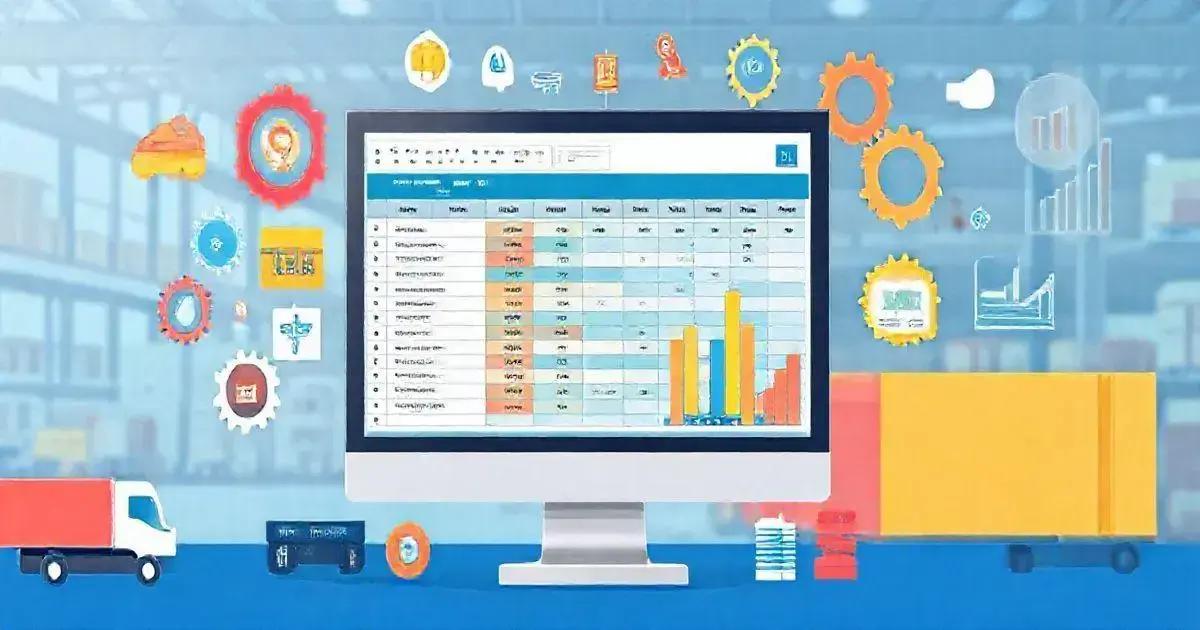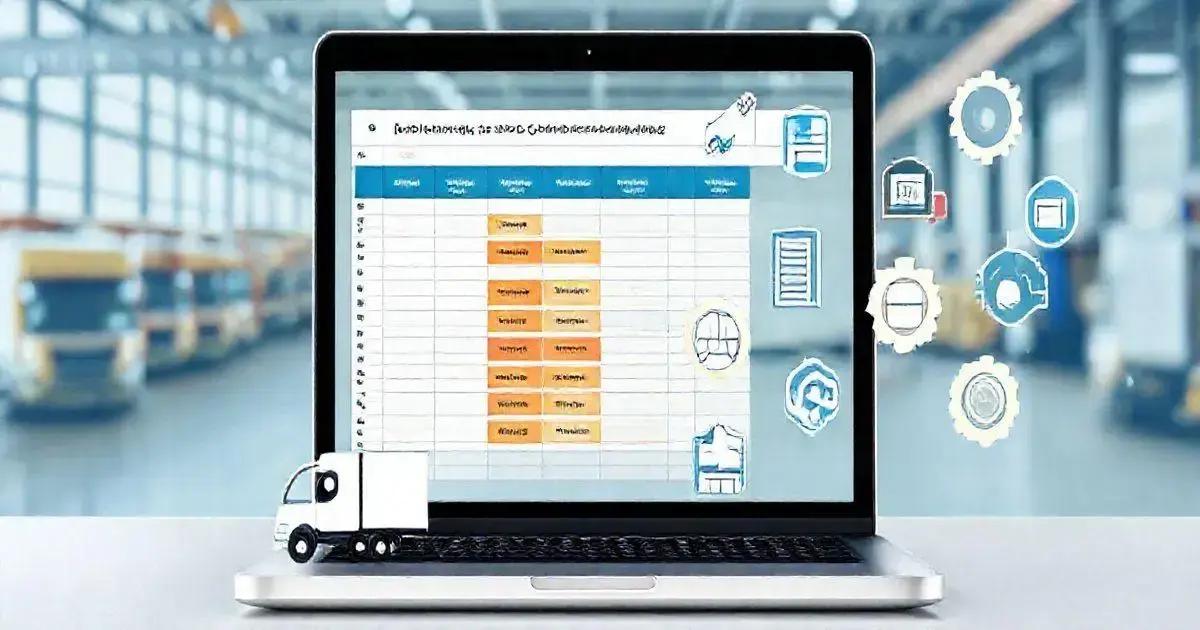Top 7 Benefits of the Fleet Control Worksheet 7.0 Leave a comment
The Fleet Control Worksheet 7.0 is a vital resource for fleet managers, designed to enhance operational efficiency through features like dashboards for tracking travel logs and maintenance schedules. It allows for easy customization and regular updates, helping users improve organization, decision-making, and cost savings in fleet management.
Managing a fleet of vehicles can be a daunting task, but the Fleet Control Worksheet 7.0 is here to simplify that process. This comprehensive spreadsheet template is designed to help businesses keep track of essential data, including travel logs, maintenance schedules, and expenses. Users can easily monitor every aspect of their fleet, ensuring optimal performance and resource allocation. Let’s explore the numerous benefits this worksheet offers to fleet managers and logistics professionals alike.
Introduction to Fleet Control Worksheet 7.0
The Fleet Control Worksheet 7.0 is a groundbreaking tool designed specifically for fleet managers looking to streamline their operations and enhance efficiency.
This Excel-based spreadsheet integrates several functionalities, allowing users to manage their fleets effectively and with ease.
Imagine having a clear overview of every vehicle in your fleet, complete with real-time data regarding maintenance schedules, fuel consumption, and travel logs. The Fleet Control Worksheet 7.0 not only helps in tracking these metrics but also facilitates better decision-making through its organized structure.
No more messy handwritten logs or scattered spreadsheets—this worksheet serves as a one-stop solution for all your fleet management needs.
Whether you are managing a few vehicles or an extensive fleet, this worksheet adapts to your requirements, providing customizable features to ensure every aspect of your fleet is accounted for.
From initial dashboards that summarize your fleet’s performance to detailed sections for each vehicle, this worksheet arms you with the information needed to optimize operations.

Key Features of the Worksheet
The Fleet Control Worksheet 7.0 comes packed with a variety of powerful features that make fleet management easier and more efficient. Here’s a look at some of the key functionalities:
- Initial Dashboards: The worksheet includes initial dashboards that provide a quick overview of essential metrics, allowing fleet managers to assess performance at a glance.
- Travel and Cargo Control: Easily track each trip along with the associated cargo details, ensuring effective logistics management and accountability.
- Tire Control: Monitor tire usage and maintenance schedules, helping to prevent issues before they arise and ensuring safety on the road.
- Preventive and Corrective Maintenance Tracking: Keep a detailed log of all maintenance activities, including preventive measures and repairs, to prolong vehicle life and avoid unexpected breakdowns.
- Cost Analysis: The worksheet provides tools to analyze costs associated with fuel, maintenance, and other operational expenses, offering insights into where savings can be made.
- User-Friendly Interface: Designed for ease of use, the worksheet’s layout is intuitive, ensuring that even those with minimal Excel experience can navigate and utilize its features effectively.
- Customizable Templates: The worksheet can be tailored to meet the unique needs of your fleet, with customizable fields and metrics that can be adjusted to fit your specific requirements.
With these features, the Fleet Control Worksheet 7.0 not only simplifies the management process but also enhances the overall efficiency of fleet operations.
Benefits of Using the Worksheet
Utilizing the Fleet Control Worksheet 7.0 brings a host of benefits that can significantly impact the efficiency and effectiveness of fleet management. Here are some of the standout advantages:
- Improved Organization: The worksheet consolidates all fleet-related data into one easily accessible location, reducing the chaos of managing multiple documents and enhancing overall organization.
- Enhanced Decision-Making: With comprehensive monitoring of vehicle performance, maintenance schedules, and expenses, managers can make informed decisions based on accurate data, leading to optimized resource allocation.
- Time Savings: Automating data entry and calculations within the worksheet saves time, allowing fleet managers to focus on strategic planning rather than getting bogged down in paperwork.
- Cost Efficiency: By tracking maintenance and operational costs, the worksheet helps identify areas where savings can be made, ultimately reducing expenses and increasing profitability.
- Increased Accountability: The structured format helps track which drivers are assigned to which vehicles, ensuring accountability and improving compliance with company policies.
- Real-Time Monitoring: The ability to log and analyze data in real time allows managers to respond quickly to issues as they arise, minimizing downtime and ensuring smoother operations.
- Scalability: Whether managing a small fleet or a large one, the worksheet is scalable, easily accommodating changes in size and scope as your business grows.
Overall, the Fleet Control Worksheet 7.0 not only simplifies fleet management but also empowers managers with the tools they need to drive success and efficiency.

How to Get Started with the Fleet Control Worksheet
Getting started with the Fleet Control Worksheet 7.0 is a simple and straightforward process. Here’s a step-by-step guide to help you hit the ground running:
- Download the Template: Begin by downloading the Fleet Control Worksheet from the official website. Make sure you have a compatible version of Microsoft Excel (2007 or later) installed on your computer.
- Open the Worksheet: Locate the downloaded file and open it in Excel. Familiarize yourself with the layout and structure of the spreadsheet to understand where to input your data.
- Customize Your Fields: Depending on your fleet’s specific needs, you can customize the worksheet. Adjust the fields for vehicle types, driver information, and any other metrics relevant to your operations.
- Input Initial Data: Start by entering the initial information about your fleet. This includes vehicle details such as license plates, make, model, and year, as well as driver details and maintenance records.
- Set Up Dashboards: Utilize the initial dashboards provided in the worksheet. These will help you visualize key metrics such as fuel consumption, maintenance costs, and travel logs right from the start.
- Regular Updates: Make it a habit to regularly update the worksheet with new data, including every trip taken, maintenance performed, and fuel expenses incurred. This will ensure the worksheet remains an accurate reflection of your fleet’s performance.
- Utilize Analytical Tools: Take advantage of the analytical tools within the worksheet to generate insights from your data. Use these insights to inform your decision-making processes and improve fleet efficiency.
- Seek Support if Needed: If you encounter any issues or have questions about using the worksheet, refer to the FAQ section included with the download or contact support for assistance.
By following these steps, you’ll quickly harness the power of the Fleet Control Worksheet 7.0, turning fleet management from a complex task into a streamlined process.
Tips for Effective Fleet Management
Effective fleet management is crucial for optimizing operations and reducing costs. Here are some valuable tips to enhance your fleet management practices using the Fleet Control Worksheet 7.0:
- Utilize Real-Time Data: Always keep your worksheet updated with real-time data. This allows for timely decision-making and helps in monitoring vehicle performance and maintenance needs effectively.
- Set Clear Goals: Define specific goals for your fleet management, such as reducing fuel expenses or improving maintenance schedules. This gives you a target to work towards and helps in measuring success over time.
- Monitor Driver Behavior: Track and analyze driver behavior using the worksheet. This includes monitoring speed, fuel consumption, and adherence to maintenance schedules. Encouraging safe and efficient driving can significantly reduce operational costs.
- Regular Maintenance Checks: Use the worksheet to schedule regular maintenance checks. Preventive maintenance can help identify issues before they become costly repairs, keeping your fleet running smoothly.
- Analyze Costs: Frequently review the cost data recorded in your worksheet. Analyzing trends in fuel consumption, maintenance, and repair costs can reveal areas for improvement and potential savings.
- Invest in Training: Provide training for your drivers and fleet managers on best practices and the effective use of the Fleet Control Worksheet. Well-trained staff are more likely to utilize the tools available to them effectively.
- Go Green: Consider implementing eco-friendly practices, such as route optimization and fuel-efficient driving techniques. This not only reduces costs but also contributes to sustainability efforts.
- Leverage Technology: Integrate GPS and telematics solutions with your fleet management practices for better tracking and monitoring. Combining these technologies with the worksheet can enhance efficiency and provide deeper insights.
By applying these tips, your fleet management can become more efficient and cost-effective, leading to improved performance and enhanced profitability.

Conclusion and Final Thoughts
In conclusion, the Fleet Control Worksheet 7.0 is an invaluable tool for anyone involved in fleet management. Its comprehensive features allow for meticulous tracking of essential metrics, from vehicle maintenance to fuel consumption, empowering fleet managers to make informed decisions that enhance operational efficiency.
By leveraging this worksheet, you can streamline your fleet management processes, resulting in improved organization, cost savings, and increased accountability. Remember to regularly update the worksheet with accurate data, utilize its analytical tools, and apply the best practices shared in this article for maximum effectiveness.
Ultimately, the key to successful fleet management lies in your ability to adapt and refine your strategies. With the Fleet Control Worksheet 7.0 at your disposal, you’re equipped to tackle the complexities of fleet management and drive your business toward greater success. Embrace these tools and techniques, and watch your fleet operations flourish!
Conclusion
In summary, adopting the Fleet Control Worksheet 7.0 can revolutionize how you manage your fleet.
With its user-friendly interface and powerful features, this worksheet simplifies the complexities of fleet management, allowing for better organization, enhanced decision-making, and significant cost savings.
By regularly updating your data, utilizing the analytical capabilities of the worksheet, and following best practices, you can boost the efficiency of your operations.
The benefits of effective fleet management extend beyond just numbers; they can lead to improved safety, increased accountability, and a greater overall performance for your fleet.
Investing time in mastering the Fleet Control Worksheet will pay dividends in the long run, ultimately contributing to the growth and success of your business.
Embrace this essential tool, and take the first steps toward optimizing your fleet management today!
FAQ – Frequently Asked Questions about Fleet Control Worksheet 7.0
What is the Fleet Control Worksheet 7.0?
The Fleet Control Worksheet 7.0 is an Excel-based spreadsheet designed to help fleet managers track and manage various aspects of their fleet, including vehicle maintenance, fuel consumption, and travel logs.
How can I download the Fleet Control Worksheet?
You can download the Fleet Control Worksheet from the official Spreadsheets Templates website. Look for the product page and click on the download link.
Is the Fleet Control Worksheet compatible with all versions of Excel?
Yes, the Fleet Control Worksheet is compatible with various versions of Microsoft Excel, including 2007, 2010, 2013, and 2016.
Can the worksheet be customized to fit my fleet’s needs?
Absolutely! The worksheet allows for customization of fields and metrics to better suit your specific fleet management requirements.
How often should I update the data in the worksheet?
It’s recommended to update the data regularly—ideally after every trip or maintenance event—to ensure that the information remains accurate and useful for decision-making.
What support is available if I encounter issues with the worksheet?
If you have questions or encounter issues, refer to the FAQ section included with the download or contact customer support for assistance.

